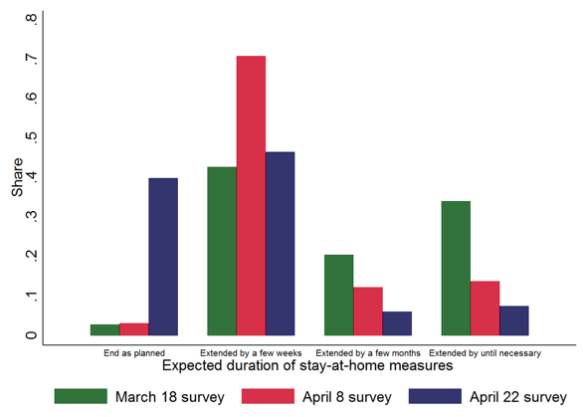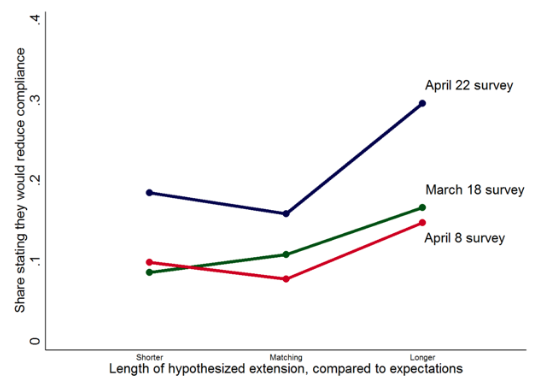Guglielmo Briscese, Nicola Lacetera, Mario Macis, Mirco Tonin
Many governments have enacted stringent ‘stay-at-home’ policies to mitigate the spread of the COVID-19 pandemic. This column reports evidence from a series of surveys of representative samples of the Italian population on their willingness to comply with the lockdown. The results indicate that people are less compliant if self-isolation measures are extended for longer than expected, which suggests that managing expectations is critical. This finding could be valuable if new waves of infections force governments to re-introduce lockdowns.
A number of countries around the world have enacted ‘stay-at-home’ measures to mitigate the spread of the COVID-19 epidemic (Baldwin and Weder di Mauro 2020). In many cases, public authorities specified an end date for the lockdown measures, but the policies were eventually extended.
For example, the Italian government extended the nationwide lockdown twice in a month: first from 3 April to 13 April, and then to 4 May. Governments may decide to implement lockdowns until deemed necessary to contain the epidemic, or they may indicate a specific end date, either committing not to extend the measures beyond that date or keeping open the option to extend them if the evolution of the epidemic makes it necessary. These alternatives involve important trade-offs (Moser and Yared 2020).
In a study based on surveys of representative samples of Italians conducted in different phases of the COVID-19 epidemic, we analysed the relationship between people’s expectations about the duration of the lockdown and intentions of compliance with the stay-at-home measures (Briscese et al. 2020).
Introducing stay-at-home measures without setting a defined end date – as was done, for example, in China, where the virus first emerged and spread – might increase the perceived severity of the situation, thereby inducing more compliance by members of the public. However, shutting down the economy and society for an unspecified period of time can have large economic and psychological costs (Brooks et al. 2020).
In China, the authorities enforced the rules strictly. In democratic countries, however, a draconian application of stay-at-home provisions is controversial and costly. Thus, limitations to personal freedom might be more acceptable if the government commits to restoring those liberties by a specified date. However, temporary measures might reduce the perceived severity of the situation, potentially reducing compliance.
Moreover, because there is uncertainty about how long the lockdown needs to be in place before it is effective at mitigating the epidemic, extensions cannot be ruled out. Extending the lockdown after creating the expectation that it would end by a certain date, however, might reduce people’s acceptance, trust in public authorities, and ultimately reduce compliance with the rules.
Compliance with COVID-19 stay-at-home measures and expectations about their duration
We conducted three surveys. We administered the first wave on 18-20 March, about ten days into the national lockdown (when contagion was rapidly rising). We ran the second wave on 8-10 April, after the first extension of the lockdown (right after the peak of the epidemic), and the third on 22-24 April, after a further extension of the stay-at-home rules until 4 May (in the descending part of the epidemic curve).
In the first wave, about 50% of respondents reported having adopted all recommended self-isolation actions. In the last wave, the share of ‘fully compliant’ individuals dropped to 42%. However, in all waves about 80% of respondents reported leaving home only when strictly necessary, which was one of the most stringent self-isolation measures.
Expectations about whether the government would likely extend the stay-at-home measures and, if so, by what duration, varied both across individuals within each wave and between waves (see Figure 1).
Figure 1 Distribution of expected end dates of stay-at-home measures, by survey wave

In the first survey in mid-March, very few people expected that the stay-at-home restrictions would actually end on the announced date of 3 April. Similarly, only a minority of respondents to the second survey in early April predicted that the measures would be lifted on the revised end date (13 April). However, in this second wave expectations were more optimistic than in the first one, with about 70% of respondents expecting the measures to last only a few extra weeks, compared to about 40% holding this belief in March.
In contrast, the respondents to the third wave of the survey in late April, for the most part, either expected 4 May (the revised official date at the time of the survey) to actually mark the end of the restrictions or that the measures would continue for a few extra weeks. Therefore, over time, individuals expected, on average, shorter and shorter remaining periods of imposed isolation.
Pushing the goalpost could hurt compliance with self-isolation measures if that clashes with people’s expectations
In our surveys, we elicited people’s intentions to comply with the stay-at-home measures if the restrictions were extended (1) by a few weeks, (2) by a few months, or (3) indefinitely (‘until deemed necessary’), with respect to the end date at the time of each survey wave.
Across the three surveys, most respondents indicated an intention to ‘maintain their current behaviour’, regardless of the length of the hypothesised extension. However, people’s willingness to comply depended on whether or not the length of the extension matched with their expectations.
Specifically, participants who would be positively surprised (i.e. extensions are shorter than expected) were more likely to increase their isolation efforts, whereas those who would be negatively surprised (i.e. extensions are longer than expected) were less willing to maintain or increase their self-isolation efforts. The effect of negative surprises was stronger in the third wave (see Figure 2).
Figure 2 Share of respondents who indicated an intention to reduce self-isolation behaviours, by (mis)match between expectations and extension scenarios

The share of respondents who reported an intention to reduce their compliance was higher, regardless of expectations, in late April than in earlier iterations of the survey. In all surveys, intentions to reduce compliance were especially higher in case of extensions that were longer than expected. Announcing a relatively short duration of self-isolation measures at the outset of the lockdown may have brought in some extra compliance, at the cost, however, of inducing people to believe that their duration could be indeed limited. This, in turn, implies a reduction in willingness to comply as the measures were progressively extended.
On 26 April (after our third survey wave was completed), Italian Prime Minister Giuseppe Conte announced that many of the stay-at-home measures scheduled to be lifted on 4 May would instead be extended for one or two additional weeks. According to our survey, this announcement may have represented a negative surprise for over 40% of Italians (Figure 1), and the findings reported in Figure 2 indicate that this could have had negative consequences for compliance.
Are others going to contribute like me?
A possible reason for an increased intention to reduce or give up compliance is the belief that others will not comply. Social isolation efforts have a public good nature, because the benefit from slowing down the circulation of the virus depends on overall effort and everybody benefits from it, regardless of their compliance with the measures.
To understand whether this mechanism may play a role, in the second and third waves we asked how long participants believed that most people would be able to maintain self-isolation behaviours (we asked the same also about the respondents themselves). We found that a sizable share of the population (about 40%) felt able to keep self-isolation for extended periods of time, whereas a much smaller share (slightly less than 15%) believed that this is the case for other people.
These relatively more pessimistic beliefs about the behaviours of others may induce people to give up too. The emphasis in the media on isolated instances of non-compliance (as anecdotally observed in Italy) might have contributed to spreading these beliefs and, as such, to actually reducing compliance. We also observe a decline between the second and third waves in people’s stated ability to continue with social isolation; this suggests that ‘social isolation fatigue’ might characterise a significant share of the Italian population.
A prolonged fight against COVID-19 and the importance of managing expectations
We found that in case of a mismatch between people’s expectations and a new deadline, people’s reported intention to comply with stay-at-home measures falls significantly. How authorities announce and extend deadlines is an important policy lever at the disposal of public authorities.
Across three iterations of our survey over five weeks, we observed that moving the goalpost resulted in larger and larger reductions in Italians’ willingness to abide by the stay-at-home rules. Because unexpectedly long extensions can reduce people’s willingness to comply, public authorities should ensure that public forms accurate expectations, transparently communicating that self-isolation is likely to be a long-term endeavour.
Managing expectations is particularly important at the current juncture, when many countries are beginning slowly to lift their lockdown measures and restart their economies. Public health experts have pointed out that the situation in most countries might not return to full normalcy until effective medication and a vaccine become available on a large scale. In particular, new waves of COVID-19 might occur, which implies that lockdown measures could be reintroduced again in the future. It is unclear how citizens would react to the request of giving up their freedoms again.
Our study shows that the public grew impatient with having to bear longer isolation periods over time, and started reacting more negatively to extensions if these were longer than they expected. Policymakers should pay close attention to how they manage people’s expectations.
References
Baldwin, R and B Weder di Mauro (2020), Mitigating the COVID Economic Crisis: Act Fast and Do Whatever It Takes, VoxEU.org eBook, CEPR Press.
Briscese, G, N Lacetera, M Macis and M Tonin (2020), “Compliance with COVID-19 Social-Distancing Measures in Italy: The Role of Expectations and Duration”, NBER Working Paper 26916.
Brooks, S K, R K Webster, L E Smith, L Woodland, S Wessely, N Greenberg and G J Rubin (2020), “The psychological impact of quarantine and how to reduce it: rapid review of the evidence”, The Lancet.
Moser, C A and P Yared (2020), “Pandemic Lockdown: The Role of Government Commitment”, NBER Working Paper 27062.
Published on VoxEU on 16 May 2020